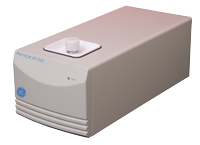 Introduction
Introduction

VP-DSC is a differential scanning calorimetry (DSC), measuring the difference in the heat required to increase the temperature of a sample and its reference. This techinque is appliable for studies of phase transition, melting point and such transitions involve energy or heat capacity changes.
For more detail, please refer to VP-DSC website.
 Important Notification:
Important Notification:
* (2015-09-20) VP-DSC is not available because of its unstable baseline.
* (2012-12-07) VP-DSC is not available because of the broken pressured cap. We are ordering a new one. Sorry for the inconvenience.
![]() * (2012-02-17) Please consult Dr. Jao if your experimental temperature is outside the range of 5 to 95ºC.
* (2012-02-17) Please consult Dr. Jao if your experimental temperature is outside the range of 5 to 95ºC.
 Features
Features
- Active cell volume ~ 0.5 ml.
- Non-reactive Tantalum 61™ cells for excellent chemical resistance.
- Fixed-in-place cells for reproducible ultrasensitive performance with low maintenance.
- Operating temperature range of 5ºC to 95ºC and with half loading, –10ºC to +130ºC.
- Peltier element for precise temperature control.
- User selectable temperature scan rates (0ºC to 90ºC per hour upscans) and range for application versatility.
- Allows studies of fast or slow transition processes.
- Self-contained pressurizing system (0-45 psi) for studying solutions above their boiling point.
- Includes ThermoVac® sample preparation and cleaning device.
- Pressure Perturbation Calorimetry accessory available for the determination of partial specific volumes.
 Applications
Applications
- Protein stability and folding.
- Liquid biopharmaceutical formulations.
- Process development.
- Protein engineering.
- Antibody domain studies.
- Characterization of membranes, lipids, nucleic acids and micellar systems.
- Assessment of the effects of structural change on a molecule’s stability.
- Measurement of ultra-tight molecular interactions (up to 1020 M-1).
- Assessment of biocomparability during manufacturing.
 Suggested Reading:
Suggested Reading:
VP-DSC Microcalorimeter User's Manual.
DSC Data Analysis in Origin Tutorial Guide.
Cooper A, Nutley MA, and Wadood A 2001, Differential scanning microcalorimetry In Protein-Ligand Interactions: hydrodynamics and calorimetry, Harding SE, Chowdhry BZ (eds). Oxford University Press; pp.287-318.

